Understanding Sherry, Should You Want to…
November 8, 2011 “Sherry!?!? Who the bloody hell drinks Sherry?!?!”
“Sherry!?!? Who the bloody hell drinks Sherry?!?!”
Well, that’s a very good question! Who does drink Sherry? The answer? Not very many people at all! Which is kind of a shame….
Being from England, drinking Sherry is almost a right of passage (saying that, it’s normally only at Christmas). I would state though, if you haven’t ever tried a good Pedro Ximenez with an aged Gouda cheese, you’re missing out! It’s been one of my few “…holy sh*t that’s good!”, wine pairing moments.
Sherry is unfortunately one of those wines that you don’t hear much about, kind of like Port; and I certainly wouldn’t consider it a trendy beverage, especially here in Florida (warm weather and all). Sherry is also a little bit of a nightmare to understand, therefore I’ve gone to all this trouble, and put together this short-and-concise guide for you!
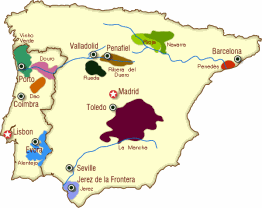 Place (click map for a larger view)
Place (click map for a larger view)
Sherry is made in the area around Jerez de la Frontera in the region of Spain known as Andalucia. It just so happens that’s it’s also one of the oldest wine making areas in all of Spain. The name sherry itself comes from an English mispronunciation of the word Jerez [pronounced: hair-reth].
This region is famous for its white-chalky soil, known as Albariza. I don’t normally get into discussing soil types on this website, as I find it quite boring, however Albariza is kind-of an exception. The chalky nature of the soil retains rainfall throughout the winter, holding in the moisture through the drier summer months when rainfall is scarce. Without this soil type, the vineyards in this region would probably not survive at all.
 Aging
Aging
Sherry wines must go through what is referred to as a Solera for aging. A Solera system is essentially a series of barrels that are linked, usually stacked in a pyramid form. Wine is removed from the bottom barrels and new wine is replaced in the top, the wine will therefore be a blend of years. Sherries therefore don’t usually bear any type of vintage date (there are a few exceptions, as always).
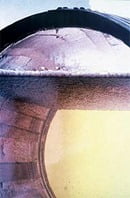 Grapes
Grapes
The 3 grapes permitted in the production of Sherry:
–Palomino: the main grape.
–Pedro Ximénez: also known as “PX”, the primary sweetening grape.
–Moscatel: also known as Muscat d’Alexandria, the main coloring grape.
One of the key terms in understanding Sherry is the term flor. Flor (as seen in the photo on the left) is simply a layer of yeasts that develop on the surface of the wine, forming a white blanket. Sounds disgusting I know! These flor yeasts feed off the acids and alcohol in the soon-to-be-sherry, and make a barrier that control the oxidation of the wine. Flor only develops on Fino-type Sherries.
Styles of Sherry
 Fino
Fino
Sharp, dry, pale, nutty and tangy, Fino can be viewed as the most delicate of all the sherry styles. The wine sees controlled exposure to oxygen, through the presence of flor yeast. Fino needs to be treated like white wine once it’s been opened. It’s a very versatile food pairing Sherry, should be served chilled, and usually doesn’t benefit from much again. The alcohol normally sits at between 15-18%.
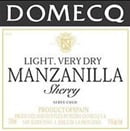 Manzanilla [Man-za-nil-la]
Manzanilla [Man-za-nil-la]
This is the lightest and most delicate of all the sherries. Manzanilla is a type of Fino, but because of the humid ocean-side environment in which they’re made, a much thicker level of flor is achieved. The wine is made in the coastal town of Sanlucar de Barrameda, which is also thought to be the reason for the salty-tang the wine yields.
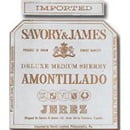 Amontillado [a-mon-til-la-do]
Amontillado [a-mon-til-la-do]
This is just an aged fino that, after losing its flor, goes on to develop whilst being exposed to oxygen. The wine is amber in color, with a distinct nutty character. It’s fortified to around 17.5% alcohol to protect it during its development, and because it has been aged in contact with oxygen, it will last for longer once opened.
 Palo Cortado
Palo Cortado
This type of sherry starts its life as a Fino, then after it loses its flor, it develops into an Oloroso by oxidizing, and developing a dark color and nutty flavor. Confusing, huh!?!? After a few months, the wine gets fortified to between 18-20% cent alcohol. Palo Cortado can be viewed as one of the rarer styles of sherry.
 Oloroso [o-lo-ro-so]
Oloroso [o-lo-ro-so]
Oloroso sherries tend to be more expensive, since they typically age for longer. Since the barrels containing the wine aren’t filled all the way, they’re allowed to oxidize; thus giving the wine a deep golden-brown color, with a rich, complex, dry, and nutty taste.
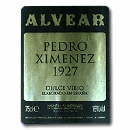 Pedro Ximenez [Peh-droh hee-meh-nihs]
Pedro Ximenez [Peh-droh hee-meh-nihs]
The wine is named after the air-dried PX grapes which which it’s made, with the wine being fortified by the addition of alcohol. Dark and usually sweet with a taste of dried raisins, this is my preferred style of Sherry.
 Cream
Cream
Cream sherries are really just a lower quality level of Oloroso. The wine is sweeter in style (usually for export to the “sweet tooth” countries), which is achieved by blending in sweetened-up Moscatel and/or PX juice. A good introduction to Sherry, and great with dessert, Cream Sherries usually contain between 15.5 and 22% alcohol.
This entry was posted in News and tagged albariza, Amontillado, Andalucia, best Sherry, Fino, Flor, Jerez, Jerez de la Frontera, Manzanilla, Oloroso, Palo Cortado, Pedro Ximenez, Sherry, Sherry wine, Spain, Understanding Sherry, what is Sherry. Bookmark the permalink. ← This Week in Wine–11.6.11 The Complexity of Wine →









